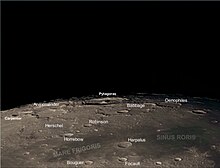
Summary
Harpalus is a young lunar impact crater that lies on the Mare Frigoris, at the eastern edge of the Sinus Roris. To the southeast at the edge of the mare is the small crater Foucault, and to the northwest on the opposite edge is the walled plain named South.
 Lunar Orbiter 4 image (triangular mark below right of crater is blemish on original) | |
| Coordinates | 52°36′N 43°24′W / 52.6°N 43.4°W |
|---|---|
| Diameter | 39 km |
| Depth | 2.9 km |
| Colongitude | 44° at sunrise |
| Eponym | Harpalus |

The rim of Harpalus is sharp-edged with little sign of wear or erosion. The wall is not perfectly circular, and has a few outward notches and protrusions, especially along the eastern half. It is surrounded by an outer rampart of ejecta, most notably towards the north, and is at the center of a small ray system. Due to its rays, Harpalus is mapped as part of the Copernican System.[1]
The inner surface is terraced, and flows down to the floor. The interior wall is the least wide along the northern face, making the floor slightly offset in that direction. Near the midpoint is a system of low central ridges.
Popular culture references edit
Harpalus was the rocket landing site in the 1950s science fiction film Destination Moon. It was chosen by artist Chesley Bonestell as it had a relatively high latitude and the Earth could be realistically displayed at a low altitude during camera shots. However, the resulting clay model depicted crazing (net-like cracks) across the crater floor, an addition to which Bonestell objected.
Satellite craters edit
By convention, these features are identified on lunar maps by placing the letter on the side of the crater midpoint that is closest to Harpalus.
| Harpalus | Latitude | Longitude | Diameter |
|---|---|---|---|
| B | 56.2° N | 43.7° W | 8 km |
| C | 55.5° N | 45.1° W | 10 km |
| E | 52.7° N | 50.8° W | 7 km |
| G | 53.6° N | 52.3° W | 11 km |
| H | 53.8° N | 53.2° W | 8 km |
| S | 51.4° N | 49.9° W | 5 km |
| T | 50.0° N | 49.4° W | 4 km |
References edit
- ^ The geologic history of the Moon, 1987, Wilhelms, Don E.; with sections by McCauley, John F.; Trask, Newell J. USGS Professional Paper: 1348. Plate 11: Copernican System (online)
- Jalufka, Dona A.; Koeberl, Christian (1999). "Moonstruck: How Realistic Is The Moon Depicted In Classic Science Fiction Films?". Earth, Moon, and Planets. 85–86: 179–200. Bibcode:2001EM&P...85..179J. doi:10.1023/A:1017015931543. S2CID 117031920.
- Andersson, L. E.; Whitaker, E. A. (1982). NASA Catalogue of Lunar Nomenclature. NASA RP-1097.
- Blue, Jennifer (July 25, 2007). "Gazetteer of Planetary Nomenclature". USGS. Retrieved 2007-08-05.
- Bussey, B.; Spudis, P. (2004). The Clementine Atlas of the Moon. New York: Cambridge University Press. ISBN 978-0-521-81528-4.
- Cocks, Elijah E.; Cocks, Josiah C. (1995). Who's Who on the Moon: A Biographical Dictionary of Lunar Nomenclature. Tudor Publishers. ISBN 978-0-936389-27-1.
- McDowell, Jonathan (July 15, 2007). "Lunar Nomenclature". Jonathan's Space Report. Retrieved 2007-10-24.
- Menzel, D. H.; Minnaert, M.; Levin, B.; Dollfus, A.; Bell, B. (1971). "Report on Lunar Nomenclature by the Working Group of Commission 17 of the IAU". Space Science Reviews. 12 (2): 136–186. Bibcode:1971SSRv...12..136M. doi:10.1007/BF00171763. S2CID 122125855.
- Moore, Patrick (2001). On the Moon. Sterling Publishing Co. ISBN 978-0-304-35469-6.
- Price, Fred W. (1988). The Moon Observer's Handbook. Cambridge University Press. ISBN 978-0-521-33500-3.
- Rükl, Antonín (1990). Atlas of the Moon. Kalmbach Books. ISBN 978-0-913135-17-4.
- Webb, Rev. T. W. (1962). Celestial Objects for Common Telescopes (6th revised ed.). Dover. ISBN 978-0-486-20917-3.
- Whitaker, Ewen A. (1999). Mapping and Naming the Moon. Cambridge University Press. ISBN 978-0-521-62248-6.
- Wlasuk, Peter T. (2000). Observing the Moon. Springer. ISBN 978-1-85233-193-1.


